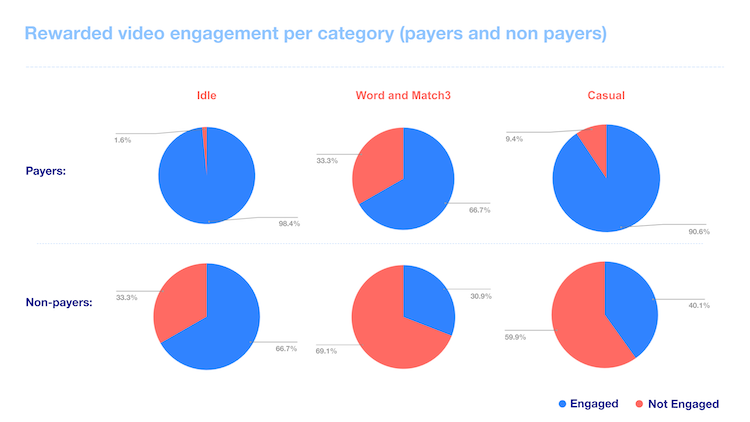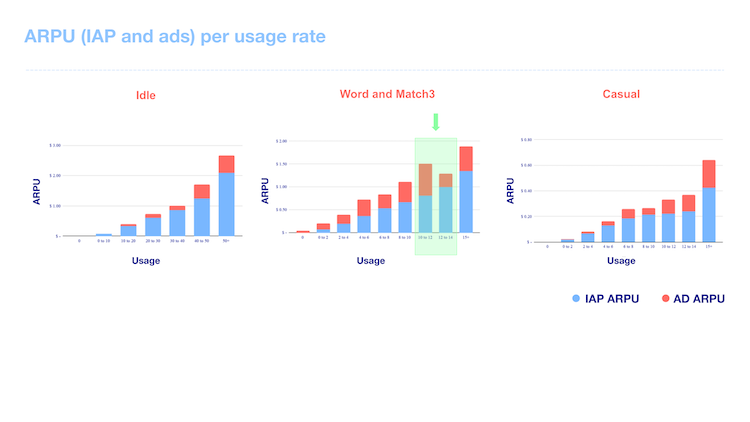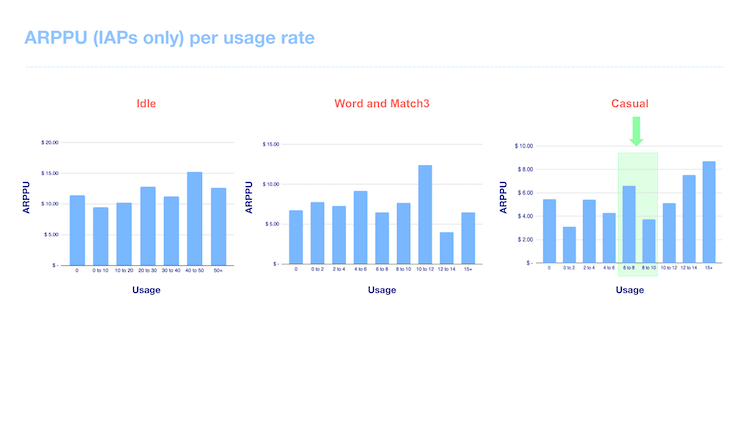Unlike interstitial or banner ads, which act as a layer on top or in between the in-game experience, rewarded ads function as an integral, native part of the in-game economy. If implemented properly, they can even increase engagement and progression within a game, or change a user’s likelihood to make an IAP. We set out to look at exactly how engagement with rewarded video would impact paying and non-paying users, and discovered some interesting and surprising things.
Methodology and Metrics
This analysis was based on test groups of three gaming categories – idle, word/match3 and casual games (including multiple sub-genres).
The metrics we looked at were ARPU (average revenue per user), ARPPU (average revenue per paying user) and IAP (in-app purchase) generated by users engaging with rewarded video ads, and also two additional important metrics we focus on at ironSource: engagement rate and usage rate. Engagement rate is the ratio of how many unique daily active users are engaging with an ad unit. It’s an important metric because the higher the engagement rate, the more, highly valuable, first impressions you’re generating, and the more users you have to show ads to.
Usage rate is the number of ads engaged users are watching daily. Unlike engagement rate where you’re aiming for the highest percentage of users, with usage rate you’re aiming for the optimal (not necessarily highest) number of views per user, to better monetize your engaged users.
Who engages more with rewarded video – payers or non-payers?
Unsurprisingly, looking at their entire lifetime in a game, there’s a clear trend towards paying users engaging more with rewarded video. This type of user is naturally more engaged with a game once they’re hooked, and is therefore more likely to engage with features that enable them to further progress in the game, like rewarded video.
Tl;dr: Paying users are in general more engaged with the game and therefore like rewarded video.
Does the engagement rate drop after a user makes an IAP?
Interestingly, across all three gaming categories, the engagement rate with rewarded video remains consistent even once a user makes a payment. This may seem illogical – once someone pays to remove ads, why would they continue engaging with them? It goes back to the difference between user-initiated (or rewarded) ads, and system-initiated ads. The ads that a user pays to remove are those that are interruptive and initiated by the game. Rewarded video on the other hand, though technically an ad unit, is initiated by the user and often acts as a feature in the game, allowing them to progress in the game (such as get free coins or retake a level) – as we saw above. A user will often make an IAP to buy items that will help them advance in the game or even to personalize their look, and, and it’s logical that they will want to protect their investment by staying in the game for as long as possible. Choosing to interact with a rewarded video at a time that suits them and that helps them progress in the game, will help them achieve this.
Tl;dr: Players will utilize rewarded video as a way to protect their IAP investment and help them remain in the game
How does usage rate affect IAP ARPU?
Based on our research, IAP ARPU (the average amount a user is worth based on their IAP purchases alone) grows in tandem with usage rate (the number of rewarded ads users watch daily). This is a result of the unique way rewarded ads work to further engagement and progression within the game as a whole. If your data shows that they’re not growing in tandem, it’s a sign that the gameplay itself may need adjusting. Try to cover where you have a challenge in the game and introduce more sophisticated and incremental monetization models, either through ads or other methods.
When reviewing usage rate and IAP activity, identify the group of users with the highest usage rate (i.e. those who are the most engaged with rewarded ads) and then try capping the number of ads and how they’re paced within the game. See how adding or taking away an ad, and/or changing its placement, has an overall effect on ARPU – for both IAPs and ads – and use the insights to increase the revenue for users who are not engaging as much as you would like.
Tl;dr: IAP ARPU and usage rate should grow in tandem – if not, look into why and try changing and testing the ads’ frequency and pacing
Your 2024 Guide to Sustainable and Profitable App Growth
Tap into the collective expertise of leaders from ConsultMyApp, AppsFlyer, Braze, and Mixpanel. Start building a profitable, and sustainable mobile growth strategy today.
Download Now
How does usage rate affect ARPPU?
This metric measures the revenue once a user turns into a paying user (i.e. not taking into account their entire journey as we saw in the first question). In the majority of cases, there’s a positive alignment between the amount users pay in IAPs (ARPPU) and the usage rate. In other words, users who watch more rewarded video ads (have a higher usage rate) before making their first purchase, are likely to then spend more money in IAPs.
However, it’s important to identify and calculate the marginal gain of the last ad impression for each group of users – that means checking how implementing one more ad affects your bottom line, and building a data-focused plan accordingly that can be A/B tested accurately. In some cases, as highlighted in the example below, adding an additional rewarded video (increasing the usage rate) may actually lower the ARPPU.
Tl;dr: Users who watch more rewarded ads before their first IAP purchase are likely to spend more in IAPs, so test the optimal number of ads to find this sweet spot
Will users engage with fewer or more ads after paying for an IAP?
Though overall there’s no change in the usage rate following a purchase, when we dive deeper into the stats, we can see fluctuations. Ultimately, every genre and group of users is different. In some cases heavy ad consumers increase their usage following a purchase and in other cases t decreases. The goal here is to get to know your different users and implement a tailored, detailed segmentation strategy. This can be done by testing different capping practices for paying users before and after making an IAP, and specifically in the immediate time after the payment was made.
Tl;dr: Get to know your different users, try various ways of segmenting them, and then test capping for each different group
Can usage rate be correlated to the probability of a user making a payment?
Flipping the analysis on its head, if we know how usage rate is affected once a user pays, can we deduce from the usage rate early on, how likely a user will be to make an IAP? The short answer to this question is yes, with idle games showing a particularly strong correlation.
So what should you test?
First, segment users based on how many rewarded videos they watch or are likely to watch. Second, understand that there are differences in behavior after a payer makes an IAP, so reward each group of players differently depending on where they are in their journey, changing the virtual currency type or the amount. Finally, test the ideal frequency of ads and implement capping.
How should you test?
Make sure to run valid A/B tests so that your data is reliable – allow enough time and a large enough volume of users to get statistically thorough results, and make sure your data doesn’t suffer from cross-test contamination with other tests.
In summary, remember that there is a strong correlation between IAP & rewarded video in both engagement and usage rate. Every genre has its sweet spot – find out what it is and optimize towards it. Ultimately, you should treat rewarded video as a feature in the game – that means A/B testing, segmenting and taking an analytical approach to how it’s implemented.
















